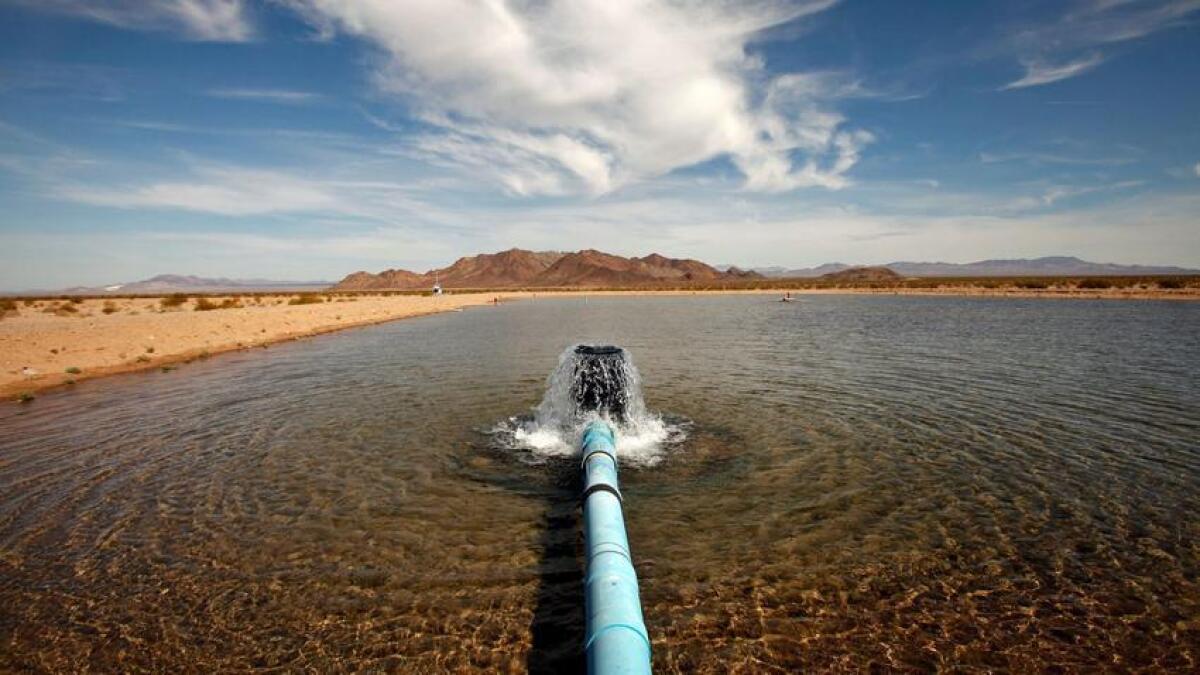Controversial Cadiz water pipeline gets OK from federal government

In an about-face, the federal government has given Cadiz Inc. the go-ahead to lay a pipeline for its proposed desert water project in an existing railroad right-of-way.
The decision by the U.S. Bureau of Land Management follows other Trump administration moves to eliminate a legal hurdle erected in the company’s path when President Obama was in office.
For the record:
12:10 p.m. Oct. 17, 2017An earlier version of this article reported that Cadiz Inc. lobbied the Interior Department to rescind the 2011 legal opinion that had underpinned its decision in 2015 to deny Cadiz permission to use a railroad right-of-way for its water pipeline. Cadiz lobbied the department to rescind the 2015 ruling.
In 2015, the BLM said Cadiz couldn’t use the right-of-way and would have to obtain federal permission to run the 43-mile pipeline across surrounding federal land. That would have triggered a lengthy environmental review that could have imposed new restrictions on Cadiz’s plans to pump groundwater from its desert holdings 200 miles east of Los Angeles and sell it to Southland communities.
The project has been approved under state environmental law, but Sen. Dianne Feinstein (D-Calif.) and public lands advocates long have fought Cadiz, arguing that the groundwater pumping would deplete the local aquifer and harm the fragile desert ecosystem in nearby wilderness areas.
Following the BLM’s 2015 ruling, the company founded by investor Keith Brackpool enlisted support from 18 members of Congress and lobbied the Interior Department to rescind it.
Last month the agency’s solicitor’s office withdrew the 2011 legal opinion that underpinned the denial, clearing the way for the BLM to make a 180-degree turn on the question of whether the water pipeline furthered a railroad purpose and could therefore be built on the right-of-way granted by the federal government under an 1875 law.
In a letter Friday to Cadiz’s chief executive, the BLM’s acting director in Washington wrote that after “further review of the relevant law,” his agency concluded that the Arizona and California Railroad could let Cadiz use the right-of-way without BLM authorization.
“The company is very pleased to receive this letter from the BLM,” Scott Slater, Cadiz president and chief executive CEO, said in a statement. “We have long maintained that the 2015 evaluation by BLM was wrong on the law, wrong on the facts and inconsistent with the policy driving co-location of infrastructure in existing rights-of-way.”
But opponents are likely to challenge BLM’s latest decision in court.
“The BLM is not the first or last word” on the federal law that governs railroad rights-of-way, said attorney Adam Keats, who has challenged the project on behalf of nonprofit groups. “The courts are,” he said. “And the courts have already interpreted the law in a way that is completely contrary to this new alternate perspective by the Trump administration.”
Even with the BLM ruling, Cadiz’s pipeline faces another challenge.
The California lands commission recently informed the company that the right-of-way crosses a 200-foot-wide strip of state land — meaning that to use it, Cadiz will need a lease from the state.
Twitter: @boxall
More to Read
Sign up for Essential California
The most important California stories and recommendations in your inbox every morning.
You may occasionally receive promotional content from the Los Angeles Times.










